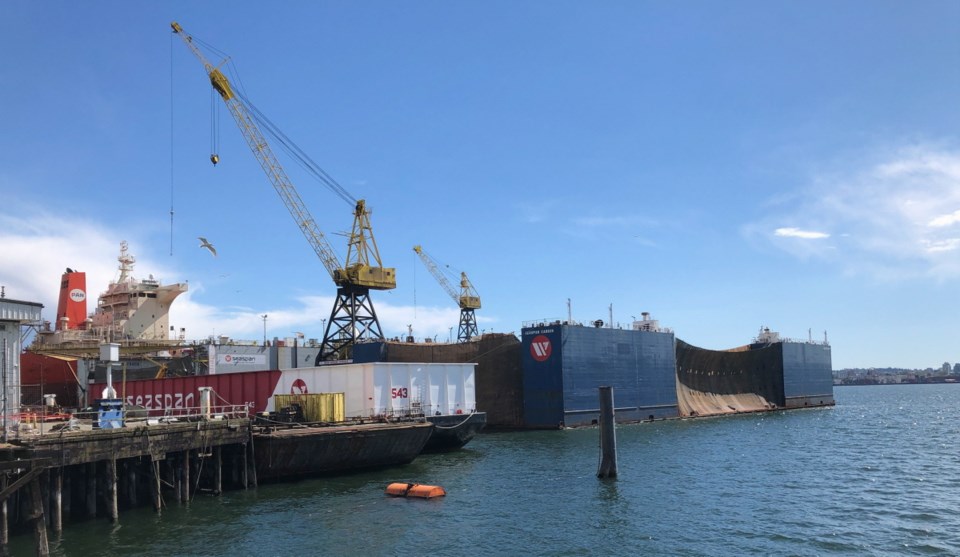Seaspan Shipyards delivered its first ship under the multibillion-dollar National Shipbuilding Program to the Canadian Coast Guard on Thursday, two years behind its initial schedule after production problems and the growing pains of rebuilding an industry.
“We haven’t arrived at this alone,” Seaspan CEO Mark Lamarre was careful to point out, talking about the growing pains that the yard has had ramping up a rebuild of the West Coast’s shipbuilding industry in a few years.
Lamarre argued that the federal government has had to relearn just as much about how to specify what it wants in new ships and order them as Seaspan has had to about building them and it is all “a work in progress.”
“[However] I couldn’t be more pleased with what we’ve demonstrated with the [following] ships,” Lamarre said.
As Seaspan hands over the first vessel, the 64-metre CCGS Sir John Franklin, there is no rest at the company’s North Vancouver shipyard. There, 1,200 shipfitters, welders, machinists and other trades are busily assembling modules of the third coast guard ship being built under the contract (the second, another fisheries research vessel, was launched June 5 for completion work and sea trials).
And they’re now deep into building components for the fourth ship, the first of two joint-support vessels for the Royal Canadian Navy, the construction of which was accelerated under the program.
In 2011, Seaspan won what was then an $8-billion contract to build ships for the coast guard and non-combatant supply vessels for the Navy under the program.
A bigger contract to build combat vessels for the Navy went to Irving Shipbuilding in Nova Scotia.
However, budgets for the program have ballooned and timelines extended, which Lamarre, a third-generation shipbuilder with 35-years’ experience in the industry, said isn’t unexpected.
“Original schedules and budgets are almost all the time wrong and optimistic,” Lamarre said, when a government embarks on an ambitious plan to commission new naval and coast guard ships after decades of inactivity in the sector. Critics have questioned why Canada would spend increasing amounts of tax dollars to rejuvenate domestic shipbuilding when they could save money by buying ships virtually off-the-shelf from allies overseas.
In 2017, for instance, an Italian-French consortium offered an unsolicited bid to build 15 new naval frigates for Canada at a fixed cost of $30 billion, versus a now-anticipated $60 billion cost for the program in Canada. Lamarre, however, argued that Seaspan is trying to position itself to be cost-competitive enough to enter the export market itself while building a “sovereign capability” for Canada.
The CEO is a relative newcomer to the program having arrived at Seaspan just under a year ago with a team of experienced senior managers with between 30 and 40 ship completions under their belts to shepherd the program through its next phase.
Lamarre has 24 years at a shipbuilding subsidiary of U.S. defence contractor General Dynamics. And he led the Australian firm ASC through a similar program. “The similarities to Australia here are so stark,” Lamarre said. “We’re using basically the same game plan.”
Seaspan has an “enthusiastic, young, highly skilled workforce,” Lamarre said, but “you only get three-ships worth of experience after you build three ships.”
And while Seaspan is trying to set international benchmarks for ship construction, “the people who are going to get there the fastest are the people who have seen 30 to 40 ships.”
Economically speaking, besides the thousand or so jobs that the program has created, which now makes Seaspan B.C.’s biggest manufacturer, Lamarre said Canada is starting to experience a boost within the supply chain the shipyard has established to feed its operations. Steel for the Navy’s joint-support vessels now regularly rolls into North Van from Algoma Steel in Sault Ste Marie, Ont.
In total, Lamarre said Seaspan has spent $935 million with some 630 different suppliers across Canada, with $405 million staying with 472 companies in B.C.
This month, the Canadian Press reported that the federal government had removed construction of a heavy icebreaker for the coast guard, the CCGS John G. Diefenbaker from Seaspan’s contract. Fisheries Minister Jonathan Wilkinson was quoted as saying that government was “exploring other options to ensure the [icebreaker] is built in the most efficient manner,” though no decisions have been made.
On Wednesday, Lamarre said Seaspan is still in discussions over the ship, but looks to another decision to award Seaspan an additional 16 multipurpose vessels for the coast guard as a vote of confidence in the program.



